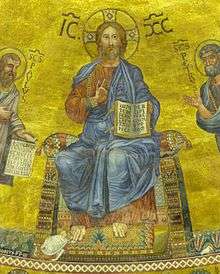Christology: A Biblical, Historical, and Systematic Study of Jesus
 | |
| Author | Gerald O'Collins, SJ |
|---|---|
| Country | United Kingdom |
| Language | English |
| Subject | Christology |
| Genre | Theology |
| Publisher | Oxford University Press |
Publication date | 9 July 2009 (2nd revised ed.) |
| Media type | Paperback, E-Book at Google Books |
| ISBN | 978-0199557875 |
| 232 | |
| LC Class | 2009-926738 |
| Preceded by | Jesus: A Portrait |
| Followed by | Rethinking Fundamental Theology |
Christology: A Biblical, Historical, and Systematic Study of Jesus is a 2009 theological book by the Australian Jesuit priest and academic Gerald O'Collins. This work was originally published in 1995 with the title Christology: A Biblical, Historical, and Systematic Study of Jesus Christ, but the author thoroughly revised the whole text in 2009 to take account of the numerous biblical, historical, and systematic studies of Jesus that appeared following its first edition.[1]
Synopsis
In this revised and updated second edition of his account of systematic Christology, O'Collins critically examines the more authoritative biblical and historical scholarship before confronting some key questions about orthodox faith and free will as applicable to Jesus in his person, being, and activity.[2] In seeking to clarify the essential truths about him, the book investigates who Jesus was/is and what he did/does.
O'Collins attempts to answer some difficult questions: Was Jesus both human and divine? If so, how is that possible and not a blatant contradiction in terms? "Surely - he writes - we cannot attribute to one and the same subject the attributes of being simultaneously finite (as a human being) and infinite (as Son of God)?"[3] The author proposes that one should envisage Jesus' revealing and redeeming 'work' as having an impact not only on all men and women of all times and places, but also on the whole created cosmos. Recognising the difficulty in describing or even minimally explaining Christ's salvific 'work', the book is built around the resurrection of the crucified Jesus, highlights love as the key to redemption, and proposes a synthesis of the divine presence through Jesus.[4]
The second edition includes fresh material on current discussions in the study of Christology: the use of 'near-death' and bereavement experiences as analogies to the post-resurrection appearances of Christ; contemporary philosophical theology and the case for the theological coherence of the Incarnation; the universal redemptive activity of Christ; and the place and possibilities of 'presence' as an organising category in Christology.
Furthermore, the author covers specific theological approaches including Martin Luther's theology of the cross and liberation theology.
Contents
Chapter 1 - Some Major Challenges
- History
- Philosophy
- Language
- Content, Emphases, and Context
Chapter 2 - The Jewish Matrix
- Five Titles
- Two Closing Comments
Chapter 3 - The Human History
- Some Preliminaries
- Proclaimer of the Kingdom
- Personal Authority
- Son of Man
- Self-Identity
- Faced with Death
- Conclusion
Chapter 4 - The Resurrection
- The Claim
- First Ground for the Claim: The Appearances
- The Appearances Challenged
- A Secondary Sign
- Other Factors
- The Resurrection as Revealing
- Resurrection as Redemptive
God's Activity Chapter 5 - The Son of God
- Dating the Title
- The Title's Meaning
- Naming the Son of God
Chapter 6 - Lord, Saviour, God, and Spirit
- Lord
- Further Appropriations
- Saviour and God
- Spirit
- Trinity
Chapter 7 - To the First Council of Constantinople
Chapter 8 - Ephesus, Chalcedon, and Beyond
- After Chalcedon
- Into the Middle Ages
Chapter 9 - Medieval and Modern Christology
- Thomas Aquinas
- To the Reformation
- The Background for Today
Chapter 10 - Divine and Human
Chapter 11 - Faith, Holiness, and Virginal Conception
- The Faith of Jesus
- The Sinlessness of Christ
- The Grace of Christ
- The Virginal Conception
Chapter 12 - Redeemer
- The Human Need
- Christ's Saving Work
- Saved by Love
Chapter 13 - Universal Redeemer
- The Redeemer of All
- Grounds for a Universal Claim
- The Salvation of the Non-evangelized
- A Coda
Chapter 14 - The Possibilities of Presence
- Chapters 2-13 on Christ's Presence
- A Philosophy of Presence
- The Revealing and Saving Presence of Christ
- Three Further Advantages
- Conclusion
Bibliography - Index of Names - Biblical Index
See also
- Jesus Christ
- Christology
- Christian Theology
- Views on Jesus
- Related lists
References
External links
- Review by RBL 2010, Society of Biblical Literature.
- Text Presentation, 1995 ed., on Questia.
- Christology on Goodreads. Accessed 31 October 2012
- Encyclopaedia Britannica, Christology - full access article
- "Jesus Christ." Encyclopædia Britannica. 2009. Encyclopædia Britannica Online. 12 Nov. 2009
- From Jesus to Christ: The First Christians — documentary about Jesus' life and the early Church.